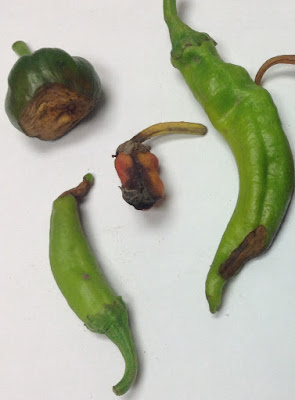 |
| Blossom end rot on peppers (Photo: N. Goldberg, NMSU-PDC) |
Featured Diagnosis – Blossom end rot. Every year many home gardeners and commercial growers become concerned about a large tan to black spot on the bottom of fruit, especially on peppers and tomatoes. No fungi, bacteria, or any other living disease organisms are known to cause the condition, and it is not spread from one plant to another. This is “blossom-end rot,” a physiological disorder caused by a calcium deficiency in the developing fruit compounded by an imbalance in water and plant nutrients. It is especially problematic in the heat of the summer. As the weather warms and the plants begin to grow more rapidly, requirements for water and calcium increase. Because calcium is not a highly mobile element, a fluctuation in water availability—even for a short period—can result in a deficiency. It is at this time that fruit begins to show symptoms of blossom-end rot.
The disorder first appears as a brown discoloration on the blossom end of the fruit (the end opposite the stem). On chile fruit, the spot occasionally will be off to the side of the blossom end. The spot enlarges as the fruit matures and may eventually cover up to half the fruit. With age, the lesion tissue becomes sunken and leathery. Eventually, secondary fungi or bacteria may invade the tissue. Secondary invasion results in a black or watery appearance. Affected fruit ripens faster than unaffected fruit.
 |
| Blossom end rot on peppers (Photo: J. French, NMSU - PDC) |
 |
| Blossom end rot on tomato fruit (Photo: NMSU-PDC) |
 |
| Blossom end rot on pepper fruit (Photo: J. French, NMSU-PDC) |





No comments:
Post a Comment